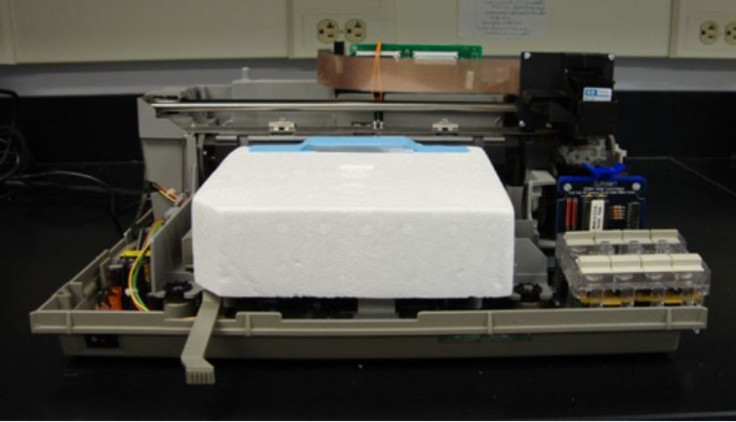Scientists Use Inkjet Printer To Print Live Cells

A modified inkjet printer not only can print cells, but can help researchers study and visualize cell changes better and faster than current methods, according to a new study.
Bioengineers from Clemson University developed cell printers previously, but only recently discovered that the printing process opens pores in the cell membrane. The opening allows researchers to incorporate visual markers such as fluorescent molecules inside the cells during printing.The molecules act as x-rays that can light up parts of cells such as the interior scaffolding, called the cytoskeleton. Researchers lit up cardiovascular cells to study how the cells react to squeezing.
This method allows us to push on the cells and watch the response easily, Dr. Delphine Dean, study author and assistant professor of bioengineering at Clemson University, said in a statement.
Printing cells is significantly faster than manually injecting cells with molecules, the authors wrote. Researchers cleaned a regular off-the-shelf ink cartridge and filled it with bio-ink, a solution of cells and saline solution. Thousands of cells per minute can be printed directly onto slides using this method.
The advantage of using thermal inkjet printing to inject molecules into cells is that the technique is relatively benign to cells, the authors wrote. Other than opening the membrane, the cell doesn't seem to be affected. The membrane closes after a few hours and the cell is just as viable as it normally is.
Researchers were limited in what can be put into the cells, however. The membranes opened 10 nanometers, 100 times smaller than the thickness of a human hair, so only molecules smaller than that can be implanted.
Bioprinting has shown promise as an efficient and cost-effective method for tissue engineering, the authors wrote. The future applications of this type of device are numerous.
Potential applications include 3D cell printing, which could create organs or other structures that one day may be implanted into humans.
The Journal of Visualized Experiments, a peer-reviewed video-based website, published the printer modification protocol Friday.
Previous studies have shown cell printing to have novel effects. In February 2011, researchers from Wake Forest University unveiled a printer that uses cultured cells to print skin grafts onto burn victims. The technology has not been tested on humans, but received a $50 million investment from the U.S. Department of Defense, according to Geek.com.
In 2010, researchers from the University of Missouri printed an artificial vein, and in September, researchers from the Fraunhofer Institute in Germany created artificial blood vessels with a 3D printer.
So far, none of these printings have been tested in humans, but Dr. Gabor Forgacs, creator of the artificial vein and a scientist at the University of Missouri, said that will change soon.
In the next five years there will be a great breakthrough, he told NPR in 2010.
© Copyright IBTimes 2024. All rights reserved.





















